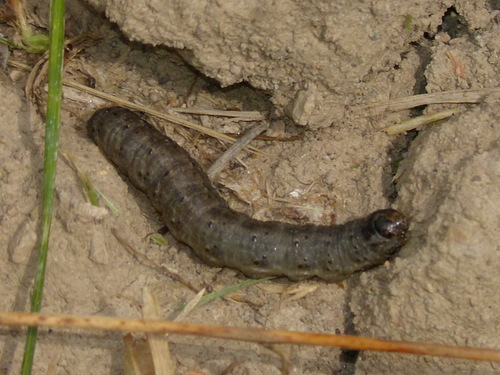Cutworms (Agotis ipsilon, Peridroma saucia)
Biology and life history: “Cutworm” is a term that describes the larvae of several moths from the Family Noctuidae. Black cutworms and variegated cutworms are two common species in the PNW that can become damaging. Cutworms are caterpillars that can reach up to 2 inches in length at later instars. Black cutworms are dark gray with a black head capsule. Variegated cutworms can be gray to brown and possess a row of yellow dots along their back. Adults are relatively large with wingspan that can exceed 2 inches (variegated cutworm: 1.25-2 inches; black cutworms: 1.5-2.12 inches). Wing coloration and pattern vary among species.
Host plants and crop damage: Larvae either climb the plants and remove leaves or feed on stems at or below the soil surface. Most cutworms feed at night and hide below the soil surface and plant residues during the day. Feeding begins in the spring and continues for several weeks until pupation in the soil in the infested field. Adults emerge during May and June to lay their eggs. Eggs hatch within a week, and cutworms feed on the foliar tissues. The next generation of adults emerges in late August and lays eggs. Variegated cutworms overwinter as larvae. If winters are mild, black cutworms overwinter as pupae. There are two generations each year.
Management: Cutworms have several natural enemies including predatory beetles, spiders and centipedes, and parasitoid wasps and flies. Their populations are susceptible to fungal diseases. Cultural control can be achieved by controlling weeds and volunteers before crop emergence. There are several insecticide options available.

